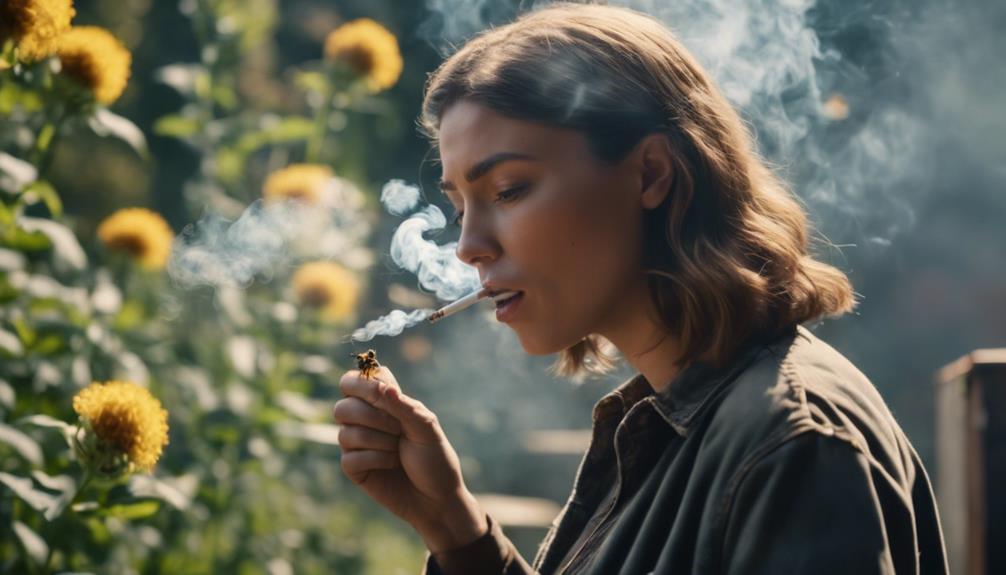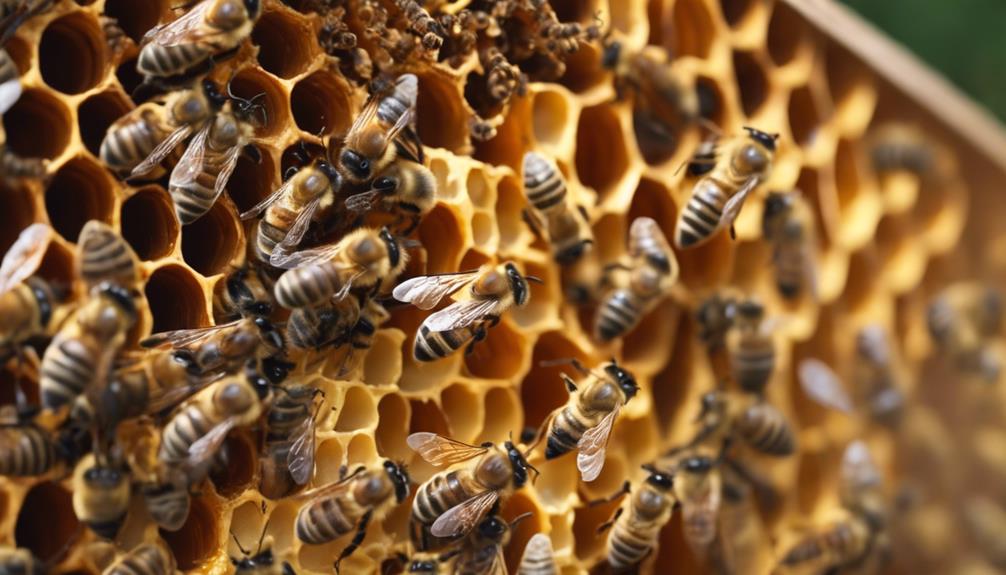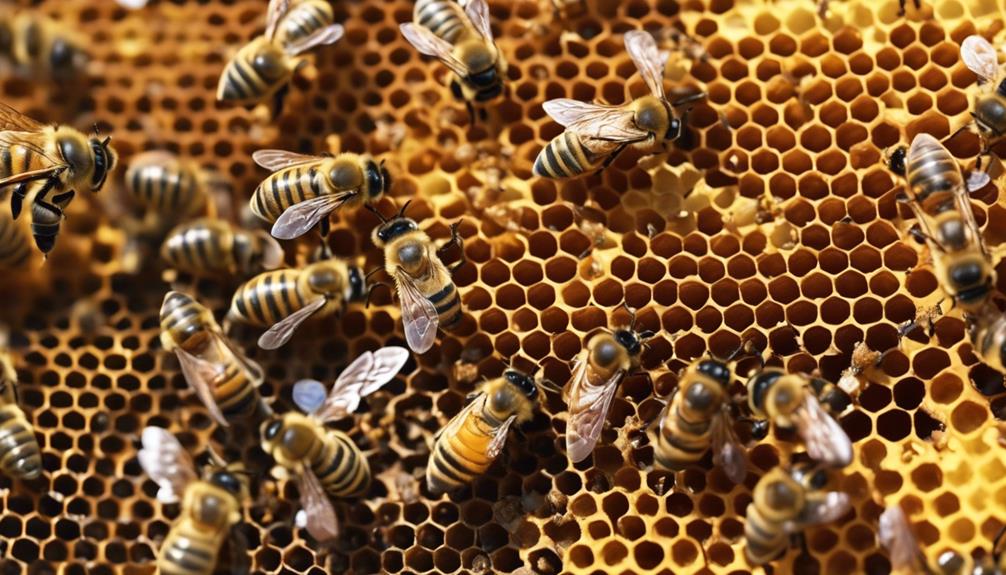Smoking bees is a common method among beekeepers to keep hives calm by disrupting bees’ smell and communication. It helps prevent aggressive alarm responses too. While it’s a widely used practice, its necessity is a hot topic in the beekeeping world. Some opt for gentler approaches like misting with water or wearing protective gear to avoid smoke. Want to uncover more nuances behind smoking bees and alternative techniques?
Main Points
- Smoking bees disrupts their communication and calms them for hive inspections.
- Alternatives like misting water, gentle blowing, or natural deterrents can also be effective.
- Using smoke is a traditional practice, but opinions on its necessity vary.
- Beekeepers should monitor behavior and use minimal, cool smoke for effectiveness.
- Sustainable beekeeping practices prioritize hive health and biodiversity for thriving bee populations.
Reasons for Smoking Bees
We choose to smoke bees to effectively calm them during hive inspections by disrupting their communication and sense of smell. Professional beekeepers rely on smoke because of its proven track record and cost-effectiveness. By using smoke, beekeepers can navigate hive management without setting off alarm responses in the bees, ensuring a smoother process.
The reliability of smoke in subduing bees and maintaining a peaceful environment within the hive makes it a top choice for beekeepers. The temporary effects of smoke, like decreasing antennae responsiveness and disrupting communication, further solidify its position as a preferred tool among beekeepers.
Effects of Smoke on Bees
The impact of smoke on bees includes disrupting their sense of smell, reducing communication, and diminishing antennae response. When we introduce smoke near bees, it messes with their ability to pick up on scents, making it harder for them to communicate with each other effectively.
Imagine trying to have a chat with a friend in a noisy, smoky room—it’s tough! The bees’ antennae, which are essential for sensing touch and smell, also get a bit confused by the smoke. But here’s the kicker: these effects are temporary, wearing off in just 10-20 minutes.
Alternatives to Smoking Bees

Introducing alternatives to smoking bees can provide effective ways to manage hive inspections without causing temporary disruptions to the bees’ sensory functions. Instead of smoke, consider using a mist of water or sugar syrup to distract bees gently.
You could also try blowing on bees softly or using a bee brush to move them without the need for smoke. Natural deterrents like peppermint oil or spearmint are excellent options to keep bees calm during inspections.
Wearing a bee veil and protective clothing can reduce the reliance on smoking bees altogether. Remember, slow, deliberate movements and minimal disturbance can go a long way in keeping bees calm without the use of smoke.
These alternatives offer freedom in beekeeping practices while ensuring the well-being of our buzzing friends.
Best Practices for Using Smoke
When applying smoke to calm bees during hive inspections, remember to gently waft a small amount over the bees rather than directing it at them. Starting with the entrance, let the smoke waft inside to calm the bees before proceeding.
Here are some best practices for using smoke:
- Use a small amount: Less is more in regard to smoke; a little goes a long way.
- Monitor bee behavior: Watch how the bees react to the smoke to make sure they’re calmed.
- Choose the right smoke: Opt for dry, cool smoke for the best calming effect.
Controversies Surrounding Smoking Bees

Amidst differing opinions in the beekeeping community, concerns have been raised regarding the necessity and potential harm of smoking bees during hive inspections.
While some beekeepers swear by the use of smoke to calm the bees and make hive management easier, others argue that it may not be essential and could even be detrimental to the bees’ health.
The ethical implications of subjecting bees to smoke have sparked a lively debate, with critics advocating for more gentle handling methods. Alternatives like sugar water sprays or essential oils have been proposed as bee-friendly options.
Ongoing research aims to illuminate the effects of smoke on bees and develop more sustainable practices for beekeepers. As the controversy swirls, bee enthusiasts are encouraged to examine all sides of the issue for the well-being of these crucial pollinators.
Historical Perspective on Smoking Bees
Exploring the historical roots of smoking bees reveals a longstanding tradition in beekeeping practices. Throughout centuries, beekeepers have relied on smoke to calm bees during hive inspections, recognizing its effectiveness in managing these buzzing creatures. Our expedition into the past uncovers intriguing insights about the use of smoke, showcasing how ancient beekeepers ingeniously crafted calming fumes using a variety of materials.
- From herbs to twigs to animal dung, beekeepers of old utilized diverse resources to produce the soothing smoke.
- Evidence from ancient Egyptian and Greek beekeeping practices attests to the long-standing tradition of using smoke to subdue bees.
- Early beekeepers’ understanding of the calming effect of smoke on bees highlights the timeless nature of this practice in maintaining harmonious beekeeping environments.
Impact of Smoke on Bee Behavior

Smoke alters bees’ behavior by disrupting their communication and reducing their antennae response. This interference with their sense of smell can lead to temporary confusion among the buzzing inhabitants of the hive.
When beekeepers use smoke during inspections, it’s like hitting the pause button on a heated debate – everything calms down. The smoke masks alarm signals, preventing a riotous response from our striped friends. Luckily, this effect doesn’t last long; within 10-20 minutes, the bees are back to their busy selves once the smoke clears. It’s a bit like a reset button for their behavior.
That’s why smoke has been a go-to tool for beekeepers; it’s reliable, cost-effective, and doesn’t leave a lasting impact on our tiny, hardworking companions.
Sustainable Beekeeping Practices
As sustainable beekeepers, we prioritize hive health monitoring to guarantee our bees thrive.
Pollination plays a vital role in our ecosystem, underscoring the significance of sustainable beekeeping practices.
Hive Health Monitoring
When monitoring hive health as part of sustainable beekeeping practices, we prioritize early detection of issues to maintain colony well-being. Regular checks help us spot problems before they escalate, ensuring our bees stay healthy and strong.
Here are some key points to contemplate when monitoring hive health:
- Regular hive inspections allow us to catch any signs of diseases or pests early on.
- Monitoring helps us prevent and manage issues within the colony, promoting a natural and chemical-free environment.
- Keeping an eye on overall colony strength is essential for sustainable beekeeping practices, promoting the long-term well-being of our precious pollinators.
Pollination Importance
Monitoring hive health is a foundational aspect of sustainable beekeeping practices, ensuring the well-being of bee colonies and their critical role in pollination. Bees are essential for the reproduction of many plants we rely on daily, from juicy fruits to nutrient-packed nuts. By implementing sustainable beekeeping methods, we safeguard bee populations, guaranteeing their essential pollination services for crops.
Farming techniques that support bees not only boost biodiversity but also create habitats where these pollinators thrive. The protection of bees through sustainable practices isn’t just about their well-being; it’s about preserving ecosystems, securing food sources, and safeguarding our environment. Sustainable beekeeping doesn’t just benefit us; it’s a win-win for native bee species and the overall health of our planet.
Habitat Preservation
Preserving natural habitats for bees to thrive is a core focus of sustainable beekeeping practices. Protecting diverse foraging areas helps maintain bee health and biodiversity.
Limiting pesticide use in beekeeping operations supports habitat preservation. Providing clean water sources near bee colonies is essential for sustaining bee populations.
Conserving natural habitats and planting bee-friendly flora contribute to long-term bee habitat preservation. By respecting the environment and supporting the natural ecosystems where bees flourish, we can guarantee their continued well-being and the essential role they play in our food supply.
Let’s work together to create a world where bees can thrive in their natural habitats, benefiting both the environment and our future generations.

Hello! My name is Noel Calvin. I graduated from UCLA and now work as a writer at Launch Ninjas. I write blog posts that inspire and guide our readers in their entrepreneurial pursuits. I live in Pleasantville, NJ, with a peaceful yet lively atmosphere that inspires me.
Writing stories is more than just a job for me. It allows me to share my observations and satisfy my curiosity about the world. I combine my analytical skills with creative enthusiasm to delve into technology trends and startup stories. But my life isn’t limited to screens and keyboards. I value loyalty, passion, and a touch of old-fashioned charm, which I infuse into every narrative I create.
I love spending time in my garage, jamming with my band when I’m not writing. Playing the guitar and singing bring me immense joy. I also enjoy capturing ordinary and extraordinary moments through my camera lens and exploring new culinary adventures that excite my taste buds. I’m always seeking new experiences.
My family is very important to me. Joyful Sunday brunches filled with laughter and intense board game nights keep me grounded, reminding me of life’s simple pleasures.
In my world, every moment is an opportunity for discovery. Every discovery is a story worth sharing, whether a heartfelt moment at home or the pulse of technological innovations. Join me as I navigate through life, one blog post, one guitar strum, and one heartwarming family dinner at a time.


